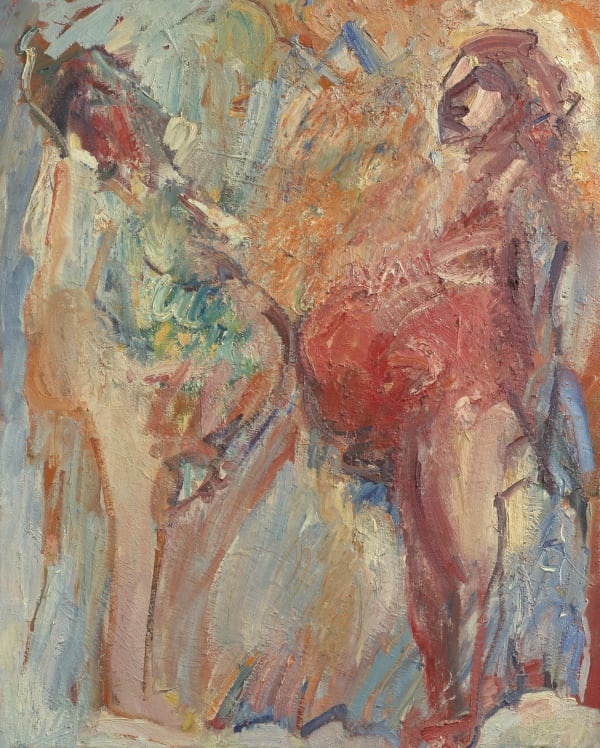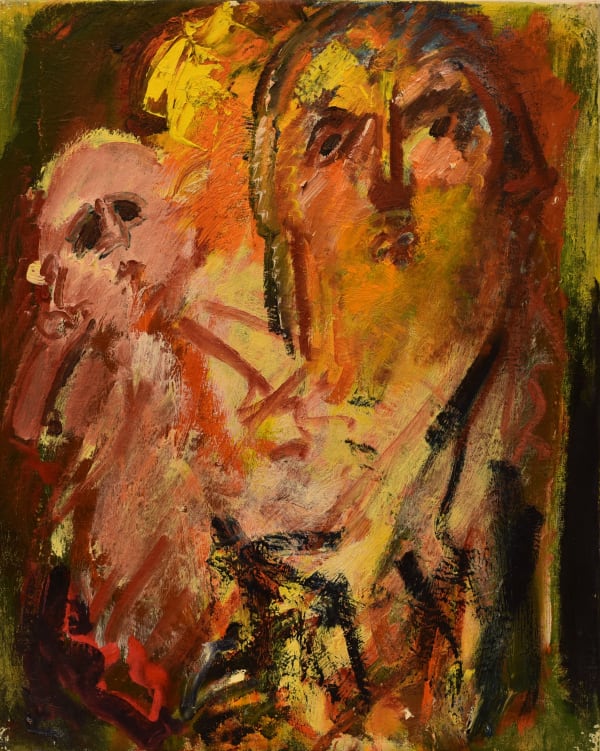The latest in our series of regularly updated Viewing Rooms highlighting particular series of works from Dennis Creffield’s career. This month, we focus on a remarkable Christmas Nativity scene, and consider the importance of Creffield’s faith to his painting
-
 The Nativity (c. 1982–84), Dennis Creffield
The Nativity (c. 1982–84), Dennis Creffield -
‘I saw a fantastic medieval Madonna in Winchester cathedral which seems to be worth anything Leonardo made’
— Dennis Creffield, 1990
For many years, each Christmas, Creffield would begin a Nativity painting; each Easter, he would make paintings of Christ’s passion. He became a devout Catholic in the 1950s, momentarily forsaking painting with a view to taking the cloth, only to be talked out of this plan by a priest, and he always had an extraordinary sense of the seasonal rituals.
The remarkable Nativity painting shown above tries to find a modern way of making a Christmas painting - the animals and the figures drawn as simply as possible; the familiar story allowed to tell itself. Just look at the gesture of Mary's arm. Creffield often spoke of the power of physical gesture in medieval painting; he had a special love of pre- Renaissance painting, which he thought lacked ego (i.e., its subject was not the artist). He loved its apparent simplicity, which was hard won, the result of immense sophistication.There are no Wise Men, no Shepherds in this painting; the animals as much as Mary and the Child are at heart of this painting. In the dress of the Virgin, there may be a reference to the traditional blue of the Virgin Mary. But this is not a super-natural scene. Like the medieval masters he so loved, Creffield has made the miracle of the Christmas story into a very human story.
-
‘He was an artist who cared about words, and whose faith showed him the possibility of words made flesh’
— Alexandra Harris, critic
Creffield’s faith was always rooted in the physical – the living, breathing, human truths at the heart of the divine mysteries of the liturgy – and his religious paintings represented means of communion with his subjects on these terms. Even as a student under David Bomberg, before his conversion to Catholicism, he completed remarkable, large-scale oils such as the work shown below, which depicts the three crosses at Calvary; muted, pale greens and yellows of the landscape give way to the vivid mosaic of bright tones with which Christ’s exposed flesh is rendered.
-

-

-

-
Above all, Creffield’s religious works are distinguished always by their intimate, physical quality. A remarkable series of charcoals he completed in the early 1980s, variously called ‘Anxious Father Anxious Baby’ and ‘God and the Baby’ (see below), humanises God as a fretting father, or else equates the fretting of the father over his young child with the Godhead. In the late 1970s and early ’80s he created an incandescent Visitation, and the vivid Nativity paintings shown above and below. He continued always to prize the Old Masters’ treatments of religious scenes, painting large-scale transcriptions of works such as Michelangelo’s Entombment. Finally, a radiant work from the very end of Creffield’s career, The Women of Jerusalem Dance, typifies the physical joy which the artist always found in faith.
-
-
 Revelation, 2008–10Oil on canvas92 x 86.5cm
Revelation, 2008–10Oil on canvas92 x 86.5cm -
 Anxious Father – Anxious Baby (or God and the Baby), 1983Charcoal on paper84.5 x 60cm
Anxious Father – Anxious Baby (or God and the Baby), 1983Charcoal on paper84.5 x 60cm -
 The Visitation, 1979–80Oil on canvas152 x 218cm
The Visitation, 1979–80Oil on canvas152 x 218cm
Private collection -
 Madonna and Child
Madonna and Child -
 Madonna and Child (after Duccio), 1988Charcoal on paper84 x 60cm
Madonna and Child (after Duccio), 1988Charcoal on paper84 x 60cm -
 The Women of Jerusalem Dance, 2008–10Oil on canvas92 x 73cm
The Women of Jerusalem Dance, 2008–10Oil on canvas92 x 73cm
-
-
 The Nativity, c. 1982–84Oil on canvas152 x 136.5cm
The Nativity, c. 1982–84Oil on canvas152 x 136.5cm













